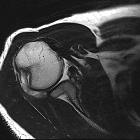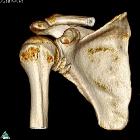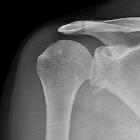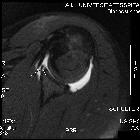bony Bankart lesion

















Bankart lesions are injuries specifically at the anteroinferior aspect of the glenoid labral complex and represent a common complication of anterior shoulder dislocation. They are frequently seen in association with a Hill-Sachs lesion.
Terminology
Strictly speaking, a "Bankart lesion" refers to an injury of the labrum and associated glenohumeral capsule/ligaments (see History and etymology below). Injury to these reinforcing soft tissue structures is thought to predispose to recurrent dislocation .
The term "bony Bankart" (contrasted with a "soft Bankart" or "fibrous Bankart") is often used to refer to fracture of the adjacent anteroinferior glenoid, an injury which also commonly occurs in the setting of anterior glenohumeral dislocation. Structurally, this fracture is thought to be less contributory to anterior instability.
Pathology
Bankart lesions occur as a direct result of anterior dislocation of the humeral head, whereby the humerus is compressed against the labrum. There is detachment of the anteroinferior labrum from the underlying glenoid, and the labral tear may further extend further superiorly or posteriorly. Impaction fracture of the anteroinferior glenoid margin commonly co-occurs.
"Soft" Bankart lesions are more common than "bony" Bankart lesions .
Associations
The same mechanism of compression can result in a Hill-Sachs lesion. Bankart and Hill-Sachs lesions are 11x more likely to occur together than isolated injuries .
Variants
- Perthes lesion of the shoulder: chondrolabral detachment with periosteal stripping of the scapula with the labral fragment attached to the periosteum
- anterior labroligamentous periosteal sleeve avulsion (ALPSA): mobilized labrum remains attached to the glenoid periosteum
Radiographic features
Plain radiograph
- +/- fracture of the anteroinferior aspect of the glenoid
CT
- glenoid labrum is not commonly visualized by CT, although CT arthrography may demonstrate labral avulsion
- +/- fracture at the anteroinferior aspect of the glenoid
MRI
- frank displacement/separation of the anterior glenoid labrum, with or without glenoid fracture fragment
- linear high T2/PD intensity through the non-displaced anteroinferior labrum, indicating tear
- abnormally small or absent anterior labrum
- double axillary pouch sign (coronal MR arthrogram): specific sign for an anteroinferior labral tear
Treatment and prognosis
Bankart lesions do heal, and therefore early surgical intervention (if any) is not required. In Bankart repairs, the labral fragment is sutured back to the glenoid rim using suture anchors.
Differential diagnosis
A number of lesions are closely related have similar appearances, see anterior glenohumeral injury for discussion of the differences.
History and etymology
This lesion is named after Arthur Sydney Blundell Bankart (1879–1951) , a British orthopedic surgeon. In his original paper, Bankart described avulsive injury of the fibrocartilaginous soft tissues along the anteroinferior glenohumeral joint occurring in association with anterior shoulder dislocation.
Although he acknowledged the frequent co-occurrence of glenoid and humeral fracture with these injuries, Bankart posited that it was injury to the soft tissue structures which specifically predisposed to recurrent dislocation . For this reason, some insist that the term "Bankart lesion" be reserved for soft tissue injury.
See also
Siehe auch:
- Frakturen mit Eigennamen
- Buford-Komplex
- anterior glenolabral injuries
- vordere Schulterluxation
- humeral avulsion of the glenohumeral ligament
- Labrumläsion Schulter
- labral Bankart lesion
- anterior glenohumeral injury
- osteochondraler Defekt des Glenoids
und weiter:
- Bankart-Läsion
- Schulterluxation
- ALPSA-Läsion
- Latarjet-Operation Schulter
- Hill-Sachs-Läsion
- capsulolabral insertion classification
- glenohumerale Instabilität
- radiologisches muskuloskelettales Curriculum
- bony humeral avulsion of glenohumeral ligaments
- Glenoidfraktur
- labral variants
- labrale Bankart-Läsion
- bankart variation lesions

 Assoziationen und Differentialdiagnosen zu Bankart-Läsion:
Assoziationen und Differentialdiagnosen zu Bankart-Läsion:



